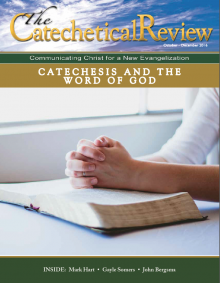Since I make my living by teaching the Bible to college students, I’m often asked to give talks on teaching Scripture, biblical catechesis, or some related theme. Over the years, I’ve given a lot of thought to what is most important when engaged in the sacred act of communicating the Word of God to other people. Obviously, most people engaged in teaching the Bible on behalf of the Church—whether priests, catechists, religion teachers, etc.—can’t devote their entire lives to Scripture study and sorting out all the challenges of interpreting the Bible. Despite that, is it still possible to do a good and faithful job, without being a professional scholar? I believe so. In what follows, I’d like to share four of the most important things to bear in mind when teaching Scripture for the Church.
1. Get the “Big Picture” for yourself.
The first task of teaching Scripture is to understand it ourselves. In his classic four-book work on Biblical interpretation entitled De Doctrina Christiana (“On Christian Doctrine”), St. Augustine says that the task of teaching the Scriptures divides into two parts: “Discovery” and “Pedagogy.” St. Augustine proceeds to write three books on the process of “discovery” or understanding the Scriptures, and then one book on “Pedagogy” or teaching. To me, that is about the correct proportion. Three times the effort should go into understanding the Scriptures ourselves, before we teach.
When I go to parishes or other venues to give an invited talk on “Teaching the Bible,” I typically make a quiet title change to “Understanding and Teaching the Bible,” and then spend most of my talk helping folks get the “Big Picture” of the biblical story line. That’s because I find that most folks do not already have the “Big Picture” of how the Bible fits together. I know that I did not see it myself until I was over thirty years old and a long way into a doctoral program in Scripture! The problem is, unless we see the “Big Picture,” Bible teaching resembles what Henry Ford is supposed to have said about the study of history: “Just one darn thing after another.” Children get such an impression from biblical catechesis: first there’s Adam, then Seth, then Abraham, then Elijah …. but why, and where is it all going?
I believe the liturgy actually helps us get the big picture of Scripture. The fourth Eucharistic prayer sums up most of the biblical story line with this statement: “Time and again you offered them covenants, and through the prophets taught them to hope for salvation.” Of course, that “hoped-for salvation” is Jesus. And that’s a pretty good summation of the Bible: a sequence of old covenants—the hope of salvation in the prophets—the fulfillment in Christ. Taking our cue from the fourth Eucharistic prayer, we can employ the sequence of covenants that God made in the Old Testament—with Adam, Noah, Abraham, Moses, David—as the backbone for teaching Scripture, how it all fits together, and how it is fulfilled in Jesus. I can’t give the big picture in the space of this article, but I’ve written a short book entitled Bible Basics for Catholics (Ave Maria Press) that does it in about 150 pages.[i] Others have written similar works: A Father Who Keeps His Promises by Dr. Scott Hahn (Servant), or the somewhat longer Epic of Eden by Protestant scholar Sandra L. Richter (IVP Academic). I highly recommend picking up one of these short, punchy summaries of the Bible story line or “salvation history” and reading through it before attempting to teach Scripture oneself. I know from experience that much of the meaning of any particular passage of Scripture has a great deal to do with how it fits into the larger plot of the Bible. I spent years in undergraduate and graduate study of Scripture unable to see this meaning because I didn’t grasp the overall plot. I wish as many people as possible can avoid all the years of frustration I went through, by getting the big picture first!
2. Teach the Bible Story, not a substitute.
One of the biggest mistakes I think homilists and catechists make, is to substitute some other, more contemporary story for the biblical narrative, and then proclaim that story and not God’s Word. Usually it works like this: a passage of Scripture is read at Mass or in class. The preacher or teacher then opens the lesson with another story—taken from their personal life, or the biography of a saint or some famous person, or current events in the news, etc. Then, the second more contemporary story (rather than the Scripture itself) becomes the basis for the homily, lesson, etc.
This practice is quite disordered, and in the worst case ends up proclaiming a different gospel. While illustrative stories are fine and can be helpful to capture attention and make a connection between Scripture and contemporary culture, we must exercise care always to return to the Scripture itself, and ensure that the point, message, or lesson is drawn directly from what God’s Word actually says.
3. Teach the Church’s faith, not a scholar’s speculations.
Our task in teaching Scripture is to transmit the Church’s faith, not the unbelief of contemporary scholars. As we all know, we live in an age of skepticism about the supernatural; and this attitude is pervasive in scholarship, including biblical scholarship. Even in the Church, it’s not uncommon that homilists, teachers, or scholars will devote a substantial portion of the educational event explaining that a certain biblical author didn’t actually write the narrative in question, or a certain miraculous event didn’t actually occur.
As a professional Bible scholar, I know how flimsy many of these skeptical opinions actually are, and how much they are influenced by the prevailing culture and its rejection of the supernatural. As teachers of God’s Word on behalf of the Church, we need to remember that we are not called to hand on the skepticism of our own age and its theories, but rather the Church’s confidence in God’s Word. It is healthy to remember that Jesus never rebuked the disciples for being gullible or believing too readily. Rather, on a number of occasions he took them to task for being “men of little faith” (Mt 6:30) who were “slow to believe all that the prophets have spoken” (Lk 24:25).
4. Test your resources by Jesus’ standard.
There are a great number of educational resources available for the teaching of Scripture: textbooks, guides, dictionaries, encyclopedias, study Bibles, etc. Even among resources that identify with the Catholic Church and claim to represent Catholic teaching, there can be strong differences in approach and scholarly opinion. When experts disagree, how is a lay person to distinguish between what is good and faithful and what is potentially misleading? Jesus knew his flock would be exposed to competing teachers claiming to represent the truth, and gave a valuable “rule of thumb” by which to discern: “By their fruits you will know them” (Mt 7:16). We can make a reliable judgment about the value of a scholar’s teaching by the fruits (or lack thereof) of holiness in his or her own life and in the lives of those who receive their teaching. So, resources that we find build up the people of God in faith, hope, and love, are probably reliable. Resources that trouble or confuse God’s people by posing impediments to faith, hope, and love, are probably unreliable.
In order to teach God’s Word to the faithful, one doesn’t have to be a professional scholar. However, teaching Scripture does require sincerity, effort, and discernment. I hope the four rules of thumb I’ve shared can assist others in carrying out this sacred task.
Dr. John Bergsma is Professor of Theology at Franciscan University of Steubenville. His books Bible Basics for Catholics and New Testament Basics for Catholics are available from Ave Maria Press. He resides with his wife Dawn and eight children in Steubenville, Ohio.
Note
[i] You may also watch a 45-minute video summary at this web link: https://vimeo.com/42695370).
This article originally appears on pages 6-7 of the printed edition.
This article is from The Catechetical Review (Online Edition ISSN 2379-6324) and may be copied for catechetical purposes only. It may not be reprinted in another published work without the permission of The Catechetical Review by contacting [email protected]


















